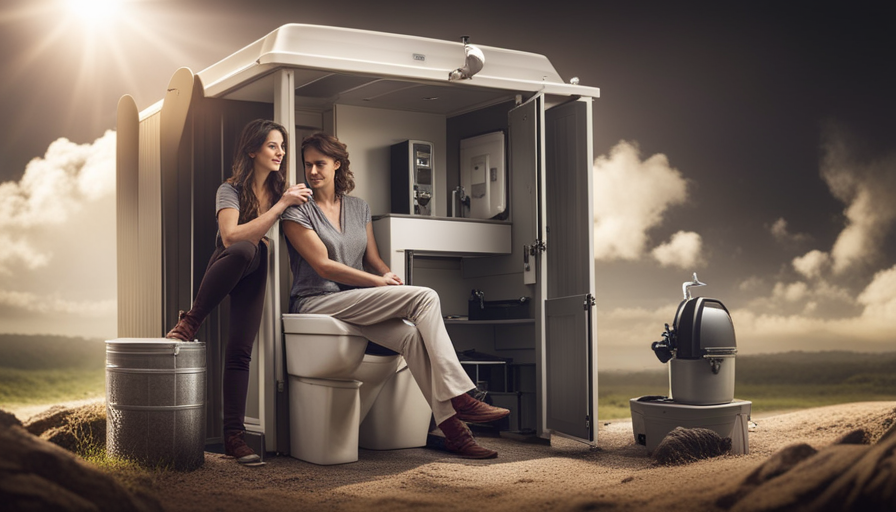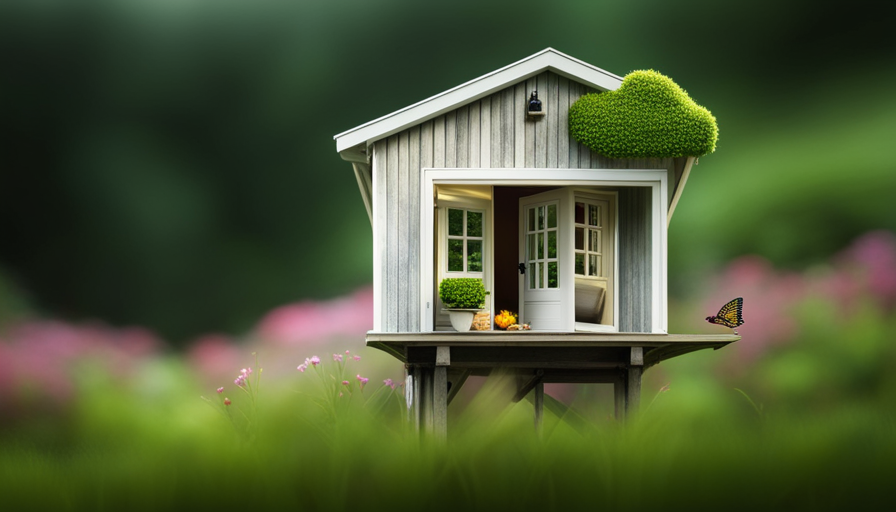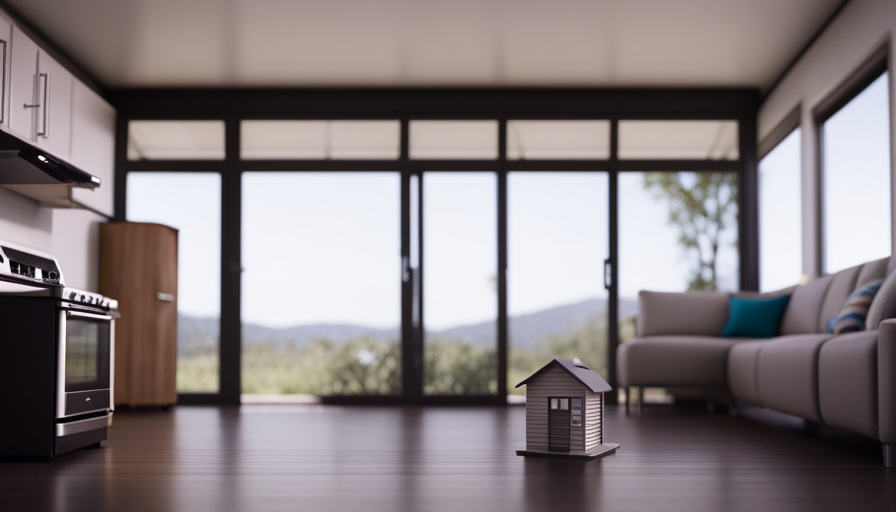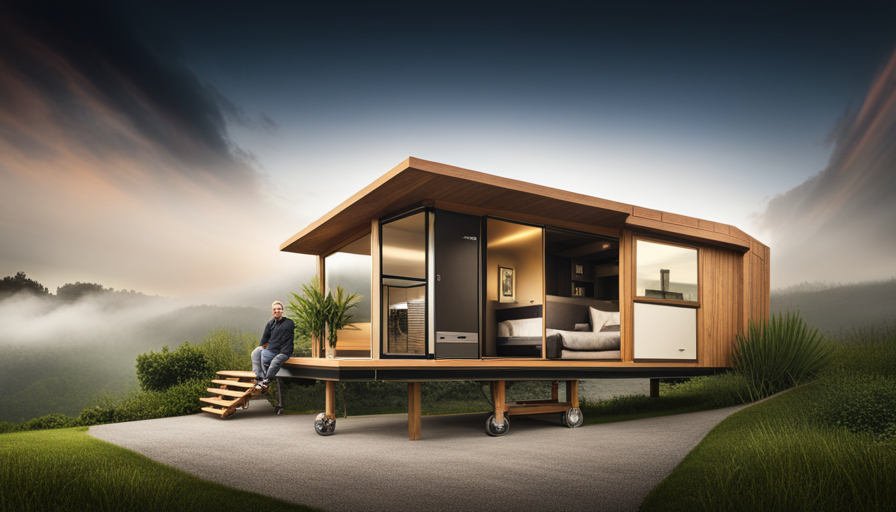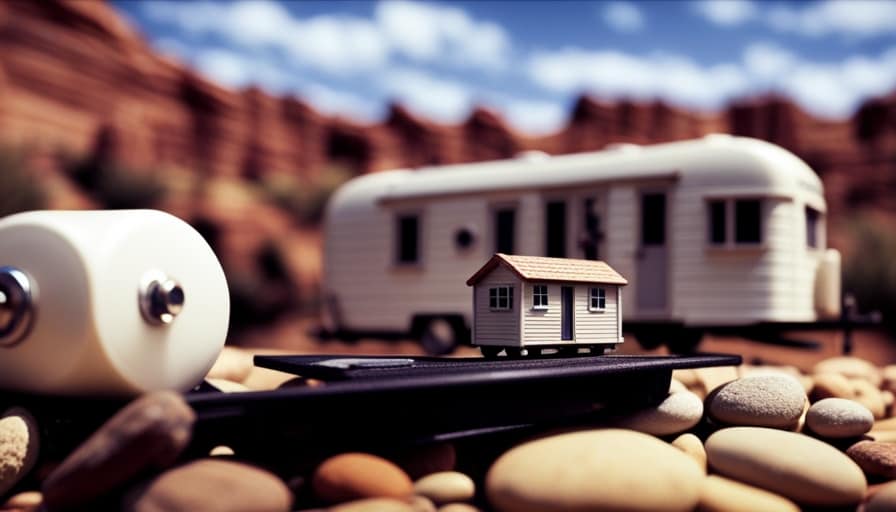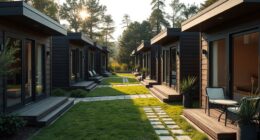The adage, ‘good things come in small packages,’ aptly applies to tiny houses as well. These small-scale homes have become increasingly popular due to their minimalist aesthetics and eco-friendly impact. Yet, residing in a tiny house presents its own distinct set of challenges, among them, understanding the functionality of the toilet in the restricted space.
In this article, I will delve into the world of tiny house toilets, exploring the different types available and the considerations that need to be made when choosing the right one. We will also discuss the plumbing systems involved, as well as proper waste disposal methods to ensure a clean and odor-free environment.
Additionally, I will provide maintenance and cleaning tips for tiny house toilets, as well as strategies for designing a functional bathroom that maximizes space efficiency. Privacy and ventilation solutions will also be explored, highlighting the importance of creating a comfortable and hygienic environment.
Finally, we will take a glimpse into the future, examining potential trends and innovations in tiny house toilets. So, if you’re curious about how to make the most out of your tiny house bathroom experience, read on for all the details.
Key Takeaways
- Types of toilets available for tiny houses: composting, incinerating, compact flush
- Proper waste disposal methods and understanding local regulations are important for clean and sustainable living in tiny houses
- Space-saving toilet options and eco-friendly waste management create functional and sustainable plumbing
- Future trends and innovations in tiny house toilets aim for efficient solutions in tiny house living
Different Types of Toilets for Tiny Houses
If you’re looking for a toilet for your tiny house, there are a ton of options to choose from that’ll make you feel like you’ve hit the jackpot! When it comes to space-saving toilets, there are several eco-friendly options that are perfect for tiny houses.
One popular choice is the composting toilet. These toilets use little to no water and instead, rely on the natural process of decomposition to break down waste into compost. They are odorless and require minimal maintenance, making them ideal for small spaces.
Another option is the incinerating toilet, which uses high temperatures to burn waste into ash, eliminating the need for water or plumbing. These toilets are compact and can be installed almost anywhere in a tiny house.
For those who prefer a more traditional option, there are also compact flush toilets available. These toilets use a minimal amount of water per flush and are designed to fit in tight spaces. Some models even incorporate a sink on top of the toilet tank, saving even more space.
When considering space considerations for tiny house toilets, it’s important to think about the overall layout and design of your tiny house. Transitioning into the subsequent section about space considerations for tiny house toilets, it’s crucial to carefully plan and allocate the necessary space for your toilet while maximizing efficiency.
Space Considerations for Tiny House Toilets
When living in a small dwelling, you’ll need to carefully plan the placement of your bathroom fixtures, taking into account the limited space available. Space saving toilet options are crucial in tiny houses, and there are several designs specifically created to maximize the use of limited bathroom space.
One popular option is a wall-mounted toilet, which is fixed directly to the wall, saving valuable floor space. Another space-saving option is a corner toilet, which fits snugly into the corner of the bathroom, making efficient use of the available area.
In addition to conserving space, eco-friendly toilet solutions are also important considerations for tiny house owners. Many eco-friendly toilets are designed to use less water, such as low-flow toilets or composting toilets. Composting toilets are especially popular among tiny house dwellers, as they not only save water but also turn waste into compost for plants. These toilets use natural processes to break down waste, reducing the need for plumbing and sewage systems.
Considering the limited space in tiny houses, it is important to choose a toilet that saves space while also being eco-friendly. These considerations for space and environmental impact seamlessly transition into the subsequent section about plumbing systems in tiny houses.
Plumbing Systems in Tiny Houses
To maximize space and ensure efficient water usage in your tiny dwelling, consider implementing a well-designed plumbing system. A properly planned plumbing system is crucial for the functionality of a tiny house. Here are some key considerations for plumbing systems in tiny houses:
-
Space-saving toilet options: In a tiny house, every inch of space matters. Opt for compact toilets that are specifically designed for small spaces. There are various options available, such as composting toilets, compact flush toilets, and incinerating toilets. These space-saving toilet options allow you to have a functional bathroom without sacrificing valuable square footage.
-
Eco-friendly waste management: Tiny houses often aim to be environmentally friendly, and waste management is no exception. Composting toilets are an excellent choice for eco-conscious individuals. They use natural processes to break down waste into compost, which can be safely used as fertilizer. Additionally, low-flow toilets and water-saving fixtures can help reduce water consumption, making your tiny house more sustainable.
-
Proper waste disposal in tiny houses: Now that you have a well-designed plumbing system, it is important to consider proper waste disposal. This can involve incorporating a greywater system to reuse water from sinks and showers for irrigation purposes. Additionally, understanding local regulations and ensuring proper disposal of solid waste is essential for maintaining a clean and sustainable living environment.
By implementing space-saving toilet options and eco-friendly waste management practices, you can create a functional and sustainable plumbing system for your tiny house. Now let’s explore the proper waste disposal in more detail.
Proper Waste Disposal in Tiny Houses
Proper waste disposal in tiny houses involves incorporating a greywater system and understanding local regulations for maintaining a clean and sustainable living environment. In order to minimize the environmental impact, many tiny house owners opt for composting toilets and portable waste disposal methods.
Composting toilets are a popular choice in tiny houses because they require no water and can turn waste into nutrient-rich compost. These toilets use a combination of natural processes, such as decomposition and evaporation, to break down human waste. The resulting compost can be safely used in gardens or disposed of properly.
Portable waste disposal systems are another option for tiny house owners. These systems typically consist of a portable tank that can be easily transported and emptied at designated waste disposal stations. It is important to follow local regulations and guidelines when using these systems to ensure proper waste management and prevent contamination.
To give you a better understanding of the different waste disposal options available, here is a table comparing composting toilets and portable waste disposal systems:
| Composting Toilets | Portable Waste Disposal Systems |
|---|---|
| No water usage | Requires regular emptying |
| Produces compost | Relies on waste disposal sites |
| Environmentally-friendly | Convenient for traveling |
Proper waste disposal in tiny houses involves considering composting toilets or portable waste disposal systems. By incorporating these methods and following local regulations, tiny house owners can maintain a clean and sustainable living environment. In the next section, we will discuss maintenance and cleaning tips for tiny house toilets.
Maintenance and Cleaning Tips for Tiny House Toilets
Keeping your toilet in good condition and ensuring cleanliness is crucial in maintaining a comfortable and hygienic living space in your tiny home. Here are some maintenance tips and cleaning hacks to help you keep your tiny house toilet in top shape.
First and foremost, regular cleaning is essential. Use a toilet brush and a non-abrasive cleaner to scrub the bowl, paying special attention to the rim and under the seat. Don’t forget to wipe down the exterior surfaces as well.
For tough stains, you can use a mixture of baking soda and vinegar or a commercial toilet cleaner.
To prevent clogs, be mindful of what you flush down the toilet. Avoid flushing items like cotton balls, wipes, or feminine hygiene products as they can cause blockages. Additionally, using single-ply toilet paper can help prevent clogging.
Another important maintenance tip is to check for leaks regularly. Inspect the connections and seals, and if you notice any leaks, repair them immediately to avoid water damage.
Incorporating these maintenance tips and cleaning hacks will ensure that your tiny house toilet remains in excellent condition. With a well-maintained toilet, you can now move on to the next step of choosing the right toilet for your tiny house.
Choosing the Right Toilet for Your Tiny House
When it comes to choosing the right toilet for my tiny house, there are several key points I need to consider.
Firstly, budget considerations play a significant role in determining which toilet option is the most suitable for my needs.
Additionally, personal preferences such as the type of flush mechanism, size, and comfort should also be taken into account.
Lastly, it’s essential to consult a professional who specializes in tiny house construction or plumbing to ensure that the chosen toilet meets all necessary requirements and regulations.
Budget Considerations
Although it may be tempting to splurge on fancy toilet options, it’s important to consider budget-friendly alternatives when outfitting a tiny house. Budget considerations are crucial in this process, as it allows for a more cost-effective solution without compromising functionality.
When it comes to toilets, there are several space-saving options that can fit within a limited budget. One such option is the composting toilet, which eliminates the need for water and plumbing connections. This not only saves money on installation costs, but also reduces water consumption.
Another budget-friendly choice is the portable toilet, which is compact and easy to install. These toilets are typically self-contained and require minimal maintenance.
When considering budget and space constraints, it’s essential to explore these affordable alternatives. However, personal preferences must also be taken into account when making the final decision.
Personal Preferences
People’s individual tastes and preferences play a crucial role in determining the best toilet option for their unique living situation. When it comes to privacy solutions in a tiny house, there are several considerations to keep in mind.
One popular option is a composting toilet. This eco-friendly solution breaks down waste into compost, which can be used as fertilizer. Composting toilets require little water or plumbing, making them ideal for tiny house living. Additionally, they’re odorless and can be easily maintained. Some models even have features like urine diverters and fans to further enhance the composting process.
However, it’s important to consult a professional to ensure that the composting toilet is installed correctly and meets all local regulations.
Transitioning into the next section, it’s essential to seek professional advice to make informed decisions about toilet options in a tiny house.
Consulting a Professional
It’s crucial to consult a professional for expert advice on choosing the right toilet option for your compact living space.
When considering professional advice, keep in mind the following:
-
Space Optimization: A professional can offer insights into maximizing the limited space available in your tiny house. They can recommend toilets that are specifically designed for small spaces, such as compact composting or macerating toilets.
-
Cost Analysis: Consulting a professional can help you assess the long-term costs associated with different toilet options. They can provide detailed cost analysis, including maintenance, installation, and potential savings on water bills.
By seeking professional advice, you can make an informed decision on the most suitable toilet option for your tiny house. This will lay the foundation for designing a functional bathroom in your compact living space, ensuring every element fits seamlessly together.
Designing a Functional Bathroom in a Tiny House
To create a functional bathroom in a tiny house, one must carefully design the layout and choose space-saving fixtures, such as a compact toilet. When it comes to space-saving bathroom fixtures, there are several options available that can help maximize the limited space in a tiny house.
One popular choice is a wall-mounted toilet, which eliminates the need for a bulky tank and creates more floor space. Another option is a corner toilet, which fits snugly into the corner of the bathroom, making efficient use of the available space.
Additionally, there are eco-friendly toilet options that can be considered for a tiny house. Composting toilets, for example, are a sustainable choice that uses little to no water and converts waste into nutrient-rich compost. There are also low-flow toilets that use less water per flush, reducing water consumption in the tiny house.
These space-saving and eco-friendly options can greatly enhance the functionality and sustainability of a tiny house bathroom.
Moving on to the next section about privacy and ventilation solutions for tiny house toilets, it’s important to consider how to ensure privacy and maintain proper ventilation in such a compact space.
Privacy and Ventilation Solutions for Tiny House Toilets
For optimal privacy and ventilation in your compact bathroom space, consider installing a small window or a skylight above the toilet area to allow natural light and fresh air to circulate.
Privacy solutions for tiny house toilets are essential, given the close proximity of the toilet to other living areas. Installing a frosted or obscured glass window allows light to enter while maintaining privacy. Additionally, you can use blinds or curtains that can be easily closed when the toilet is in use.
Ventilation options are crucial to prevent odors and maintain a fresh environment. A small exhaust fan can be installed near the toilet to remove any unpleasant smells. Alternatively, a vent pipe can be connected to the toilet to direct odors outside. This ensures that the air inside your tiny house remains clean and fresh.
Maximizing efficiency in tiny house toilets is essential for optimizing space utilization. By incorporating compact fixtures, such as a wall-mounted toilet and a slim-profile sink, you can make the most of the available space. Additionally, choosing a dual-flush toilet and low-flow fixtures will help conserve water.
Tips for Maximizing Efficiency in Tiny House Toilets
By embracing the concept of minimalism, I have transformed my compact bathroom into an efficient and functional space in my tiny house. Maximizing space is crucial in such a small area, and this applies to the toilet as well. To make the most of the available space, I have opted for a compact and sleek toilet design. Additionally, I have incorporated eco-friendly options to reduce water consumption and minimize my environmental impact.
One way I have maximized space is by choosing a toilet with a smaller footprint. This allows for more maneuverability in the bathroom and creates a visually spacious atmosphere. Another space-saving solution is installing a wall-mounted toilet. By mounting the toilet on the wall, I have freed up valuable floor space, making the bathroom feel more open and airy.
To further optimize efficiency, I have installed a dual-flush toilet. This feature allows me to choose between a full flush for solid waste and a reduced flush for liquid waste, saving me water with each use. Additionally, I have installed a low-flow toilet that uses less water per flush compared to traditional toilets. These eco-friendly options not only help me conserve water but also contribute to a more sustainable lifestyle.
Looking ahead, future trends and innovations in tiny house toilets are exciting. From composting toilets to waterless options, there are constant advancements in eco-friendly and space-saving solutions. As the tiny house movement continues to grow, I am excited to see what new technologies and designs will emerge to make our bathrooms even more efficient and functional.
Future Trends and Innovations in Tiny House Toilets
When it comes to tiny house toilets, maximizing efficiency is key. In the previous subtopic, I’ve shared some tips on how to achieve this goal. Now, let’s dive into the future trends and innovations that are shaping the world of tiny house toilets.
The future of tiny house toilets is all about finding eco-friendly options that still provide the necessary functionality. Manufacturers are constantly researching and developing new technologies to address these needs. Here are some exciting innovations to look out for:
-
Composting toilets: These toilets use natural processes to break down waste, turning it into compost that can be safely disposed of. They’re odorless, waterless, and require minimal maintenance.
-
Incinerating toilets: These toilets use high temperatures to burn waste, reducing it to a sterile ash. They’re compact, easy to use, and eliminate the need for traditional plumbing.
-
Water-saving systems: With limited space and resources in tiny houses, water-saving toilets are becoming increasingly popular. Dual-flush toilets, vacuum toilets, and low-flow options are all being developed to minimize water usage.
-
Smart toilets: Technology is making its way into tiny house toilets as well. Smart toilets can monitor water usage, detect leaks, and even analyze waste for health purposes.
As the demand for tiny houses continues to grow, so does the need for innovative and environmentally friendly toilet options. These future trends are exciting steps towards creating sustainable and efficient solutions for tiny house living.
Frequently Asked Questions
What are the different options for composting toilets in a tiny house?
There are several options for composting toilets in a tiny house. One option is a self-contained unit that separates liquid and solid waste, using a fan to promote decomposition.
Another option is a central composting system where waste is collected in a separate chamber for composting.
Installation requirements for composting toilets typically include proper ventilation, access to electricity for the fan, and regular maintenance to ensure proper decomposition and odor control.
How much space is needed for a toilet in a tiny house bathroom?
To maximize space in a tiny house bathroom, it’s crucial to prioritize efficiency. Space-saving toilet designs and alternative bathroom layouts are essential considerations. Compact toilets with smaller dimensions can be installed, saving valuable floor space. Additionally, alternative bathroom layouts can optimize the available space. For example, incorporating the toilet into a shower area or using wall-mounted toilets are viable options. By considering these choices, a tiny house bathroom can be designed to maximize functionality without sacrificing comfort.
Can a tiny house toilet be connected to a traditional plumbing system?
Connecting tiny house toilets to a traditional plumbing system is not a walk in the park. It’s like trying to fit an elephant into a shoebox!
However, there are alternatives to traditional plumbing that can make it possible. Composting toilets, incinerating toilets, and macerating toilets are some options that allow for easy installation and minimal plumbing requirements. These innovative solutions ensure that even in a tiny house, you can enjoy the convenience of a functioning toilet.
What are the regulations for waste disposal in tiny houses?
Tiny house waste disposal regulations refer to the legal requirements and environmental impact of managing waste in tiny houses. These regulations vary depending on the location and jurisdiction. It is important to comply with local laws regarding waste disposal. These laws may include guidelines for septic systems, composting toilets, or connection to a municipal sewer system. Proper waste management is essential to protect the environment and maintain the health and sanitation of the tiny house community.
Are there any specific cleaning products or techniques recommended for maintaining a toilet in a tiny house?
When it comes to maintaining a toilet in a tiny house, there are a few key factors to consider.
First, it’s important to choose the right cleaning products. Look for eco-friendly options that won’t harm your composting toilet or the environment.
As for techniques, regular cleaning and disinfection are essential. Make sure to follow the manufacturer’s instructions for your specific toilet model.
Additionally, be mindful of space requirements and any waste disposal regulations that may apply, especially if you have a traditional plumbing system.
Conclusion
As I reflect on the intricacies of how the toilet works in a tiny house, I can’t help but be reminded of a delicate dance. Like a well-choreographed performance, each component plays its part, ensuring smooth functionality in the limited space.
From choosing the right toilet type to considering plumbing systems and waste disposal, every decision contributes to the seamless operation of this essential fixture. With proper maintenance and clever design, a tiny house toilet can be a harmonious blend of efficiency and elegance.
So, let us embrace the future trends and innovations that await, as we navigate the intricate steps of this tiny house toilet ballet.
Hi, I’m Emma. I’m the Editor in Chief of Tiny House 43, a blog all about tiny houses. While tree houses are often associated with childhood, they can be the perfect adult retreat. They offer a cozy space to relax and unwind, surrounded by nature. And since they’re typically built on stilts or raised platforms, they offer stunning views that traditional homes simply can’t match. If you’re looking for a unique and romantic getaway, a tree house tiny house might just be the perfect option.
